Catalina 350 Review – Modern Boating (January 2004)
Issue: January 2004
Manufacturer: Catalina
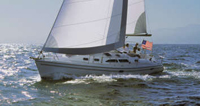 The Catalina design team, led by vice president Jerry Douglas, must have set themselves a design brief something like this. “Our job”, I can imagine Jerry saying this “is to create the most stylish and comfortable 35-footer we can. “I want to eliminate all objections any family member may have to go sailing onboard this boat”. The result is that the Catalina 350, particularly in the configuration shown here — with the optional hardtop — is remarkably easy to live with. Another way, I suppose, of saying that it is extremely comfortable and easy to sail.
The Catalina design team, led by vice president Jerry Douglas, must have set themselves a design brief something like this. “Our job”, I can imagine Jerry saying this “is to create the most stylish and comfortable 35-footer we can. “I want to eliminate all objections any family member may have to go sailing onboard this boat”. The result is that the Catalina 350, particularly in the configuration shown here — with the optional hardtop — is remarkably easy to live with. Another way, I suppose, of saying that it is extremely comfortable and easy to sail.
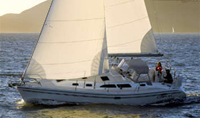 To achieve their aim the designer(s) wanted a lot of internal volume so they gave the hull plenty of beam, just under 4m of it (13ft). Then they gave it a lot of headroom (2m in the saloon, only slightly less even in the fore cabin). Then they added a list of standard equipment which is unusually comprehensive and includes even the electric anchor winch. The boat shown here will be used by owners Trevor and Lina in their retirement, and they found that to fill all their needs they needed only two optional extras — the hardtop and the electric halyard winch. Without getting into too much detail, here is a rough list of the interior’s design features. In the fore cabin the designers opted for a centre line double berth with innerspring mattress and cutouts at the sides for individual entry and exit.
To achieve their aim the designer(s) wanted a lot of internal volume so they gave the hull plenty of beam, just under 4m of it (13ft). Then they gave it a lot of headroom (2m in the saloon, only slightly less even in the fore cabin). Then they added a list of standard equipment which is unusually comprehensive and includes even the electric anchor winch. The boat shown here will be used by owners Trevor and Lina in their retirement, and they found that to fill all their needs they needed only two optional extras — the hardtop and the electric halyard winch. Without getting into too much detail, here is a rough list of the interior’s design features. In the fore cabin the designers opted for a centre line double berth with innerspring mattress and cutouts at the sides for individual entry and exit.
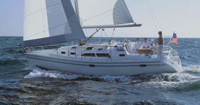 The bathroom is en suite (there is a separate door off the saloon for day use ) and features a separate shower recess with folding glass door. This avoids wetting the whole bathroom and eliminates the need to get changed outside the bathroom. The shower door, points out Catalina’s Norm Ambrose, is less than full height which prevents claustrophobia and keeps air moving around the recess. The toilet is electric, with macerator and holding tank. The waste can be pumped out or, heaven forbid, dumped overboard. The galley is a complete U-shape with plenty of support for the cook including a stainless grabrail running from floor to ceiling. The fridge is front and top-opening (“so you can easily reach the butter and cheese, which always end up on the bottom”, says Norm). The freezer is standard.
The bathroom is en suite (there is a separate door off the saloon for day use ) and features a separate shower recess with folding glass door. This avoids wetting the whole bathroom and eliminates the need to get changed outside the bathroom. The shower door, points out Catalina’s Norm Ambrose, is less than full height which prevents claustrophobia and keeps air moving around the recess. The toilet is electric, with macerator and holding tank. The waste can be pumped out or, heaven forbid, dumped overboard. The galley is a complete U-shape with plenty of support for the cook including a stainless grabrail running from floor to ceiling. The fridge is front and top-opening (“so you can easily reach the butter and cheese, which always end up on the bottom”, says Norm). The freezer is standard.
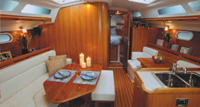 The aft cabin, on the portside, features a huge athwart ships berth which has an opening hatch immediately ahead of the sleepers’ faces for ventilation and a view outside. Those designers worked overtime to come up with a new table arrangement for the saloon. The dinette tabletop is removable and stows at the head of the aft double berth. You can have an optional pedestal ($800 extra) which lowers to form a double berth. When the table is stowed the pedestal carries a smaller tabletop to free up room around the dinette. There is another small table on the starboard side, which lowers to form a single berth. The cockpit seats are long enough to sleep on, too, so with the right options you could sleep seven below and a couple in the cockpit. Why; however, would anyone want to? Norm Ambrose reckons this is a husband and wife boat and they will tend to use the smaller tables most of the time and take their meals on the cockpit table. The Maxwell electric anchor winch is operated by toe pads under the lid of the commodious locker. A remote control unit is an option, so you can raise and lower the anchor without leaving the cockpit if you want. The anchor is carried in a substantial bow fitting with two rollers.
The aft cabin, on the portside, features a huge athwart ships berth which has an opening hatch immediately ahead of the sleepers’ faces for ventilation and a view outside. Those designers worked overtime to come up with a new table arrangement for the saloon. The dinette tabletop is removable and stows at the head of the aft double berth. You can have an optional pedestal ($800 extra) which lowers to form a double berth. When the table is stowed the pedestal carries a smaller tabletop to free up room around the dinette. There is another small table on the starboard side, which lowers to form a single berth. The cockpit seats are long enough to sleep on, too, so with the right options you could sleep seven below and a couple in the cockpit. Why; however, would anyone want to? Norm Ambrose reckons this is a husband and wife boat and they will tend to use the smaller tables most of the time and take their meals on the cockpit table. The Maxwell electric anchor winch is operated by toe pads under the lid of the commodious locker. A remote control unit is an option, so you can raise and lower the anchor without leaving the cockpit if you want. The anchor is carried in a substantial bow fitting with two rollers.
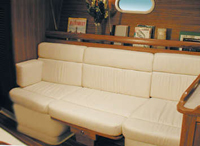 This boat has the optional fixed coach roof, a rigid top with soft sides. All sail handling can be done from the cockpit. There is a seat in each corner of the push pit, and a foot brace is part of the cockpit table structure so if you are sitting on the windward cockpit seat you can brace yourself easily. There are lockers in the transom for messy stuff like garbage or fishing gear, and a bracket for the dinghy’s outboard. The transom shower has hot and cold. The below decks layout frees up room under the starboard cockpit seat for a lazarette so deep you will need to climb down inside to clean out the bottom (there is a step). There is room for a inflatable dinghy, and just about anything else.
This boat has the optional fixed coach roof, a rigid top with soft sides. All sail handling can be done from the cockpit. There is a seat in each corner of the push pit, and a foot brace is part of the cockpit table structure so if you are sitting on the windward cockpit seat you can brace yourself easily. There are lockers in the transom for messy stuff like garbage or fishing gear, and a bracket for the dinghy’s outboard. The transom shower has hot and cold. The below decks layout frees up room under the starboard cockpit seat for a lazarette so deep you will need to climb down inside to clean out the bottom (there is a step). There is room for a inflatable dinghy, and just about anything else.
You rarely need to venture forward, although the inboard shroud anchorages mean the side decks are easy to traverse and handrails are superb. The roomy cockpit is the focus for all activity. Trevor and Lana have two grown sons and a couple of grandchildren. “This boat is a mechanism for bringing the family together”, says Trevor, “and the cockpit and dodger arrangement will keep the children in the cockpit and for us is ideal”. The rig is surprisingly sophisticated for a cruising yacht. There are two sets of spreaders; the intermediate diagonals are continuous and extend to the deck where they can be adjusted. There are fore and aft lowers; all chain plates are set well inboard so when you go forward you walk outside them.
Chainplate loads are fed by metal rods into the lower part of the hull structure proper. One Sydney owner has extended the 350’s easy handling abilities even further by specifying the in-mast mainsail furling and adding a locally made self-tacking system for the headsail. Handling this Catalina is easy. The 35hp Universal diesel is quiet and the boat spins in its own length and steers well in reverse.
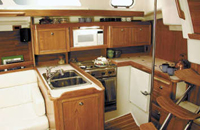 Trevor looped the main halyard onto the two-speed electric winch and the main went up quickly and easily; low speed was used only for the last little bit. Trevor pointed out that the hardtop obscured his view; you need a second pair of eyes to tell you when the sail is fully hoisted and he reckons he may add a clear panel to the hardtop. Cleat off the halyard and use the winch for the mainsheet. At the end of the sail Norm ran the furler line to the powered winch and rolled away the headsail, a 135 per cent genoa with UV strips. In-mast furling is available, but this boat had the Dutchman furling aid for the fully battened mainsail, fine lines which lead vertically through tiny eyes in the sail and fasten to a line which parallels the mainsail leech. The Dutchman’s role in life is to make the main flip flip onto the boom as it is lowered, a lightweight system simpler than lazy jacks. The standard sails looked very good. The 350 has a conventional fin keel and spade rudder, though a shallow-draught wing keel is available, a long-time Catalina option. The boat tacked well and accelerated quickly out of tacks, but we got no performance readings, because the nice sou-easter we started with faded steadily and kept fading; by the time we had settled in the breeze had gone soft and soon afterwards the diesel was the best way home. Trevor was steering under sail as we watched the masthead wind indicator lazily spin through 360 degrees in the masthead vortices.
Trevor looped the main halyard onto the two-speed electric winch and the main went up quickly and easily; low speed was used only for the last little bit. Trevor pointed out that the hardtop obscured his view; you need a second pair of eyes to tell you when the sail is fully hoisted and he reckons he may add a clear panel to the hardtop. Cleat off the halyard and use the winch for the mainsheet. At the end of the sail Norm ran the furler line to the powered winch and rolled away the headsail, a 135 per cent genoa with UV strips. In-mast furling is available, but this boat had the Dutchman furling aid for the fully battened mainsail, fine lines which lead vertically through tiny eyes in the sail and fasten to a line which parallels the mainsail leech. The Dutchman’s role in life is to make the main flip flip onto the boom as it is lowered, a lightweight system simpler than lazy jacks. The standard sails looked very good. The 350 has a conventional fin keel and spade rudder, though a shallow-draught wing keel is available, a long-time Catalina option. The boat tacked well and accelerated quickly out of tacks, but we got no performance readings, because the nice sou-easter we started with faded steadily and kept fading; by the time we had settled in the breeze had gone soft and soon afterwards the diesel was the best way home. Trevor was steering under sail as we watched the masthead wind indicator lazily spin through 360 degrees in the masthead vortices.
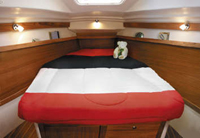 The numbers confirm she should sail well. At 6185kg the Catalina 350 is not heavy; her displacement/ length ratio puts her at the light end of the medium displacement spectrum, and the sail area/ displacement ratio is in line with other production cruisers.
The numbers confirm she should sail well. At 6185kg the Catalina 350 is not heavy; her displacement/ length ratio puts her at the light end of the medium displacement spectrum, and the sail area/ displacement ratio is in line with other production cruisers.
The 350’s design theme — and all boats have a theme — is easy use, a lot of standard equipment and a lot of clever detail design. The list of standard equipment is very long and the price is short. The result is an extremely comfortable craft in the habitat sense i.e. both down below and while sailing. But it should also be very comfortable to live on for long periods of time, as the clever detail design eliminates all the niggles, which can make long-term sailing a chore.
* Prices & data correct at time of publication
